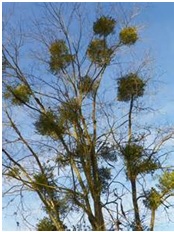Mistletoe and Wine: The Biology of mistletoe and the making of wine
 Will Cliff have the Christmas number 1 this year? Who knows, but his Mistletoe and Wine song from 1988 has stood the test of time almost as well as Cliff himself. Here we will learn about Mistletoe’s ecology, and how wine is made.
Will Cliff have the Christmas number 1 this year? Who knows, but his Mistletoe and Wine song from 1988 has stood the test of time almost as well as Cliff himself. Here we will learn about Mistletoe’s ecology, and how wine is made.
Mistletoe is the Christmas plant hung in doorways to induce passers through to kiss. It is an evergreen parasitic plant, and you can see a thoroughly parasitized tree in this picture. The tip of a mistletoe’s roots is adapted to be able to penetrate through the bark of the tree and absorb water and nutrients. You can see that the leaves of mistletoe are green, so the plant is able to photosynthesise. Mistletoe is unable to live without a host tree.
Mistletoe, like holly, is dioecious. It has separate male and female plants. Only the female plants have the characteristic white berries, and they rely on pollination from flowers on a male plant. The flowers are insect pollinated. Its seeds, found inside poisonous white berries, must germinate on the host tree. Birds will eat the berries with no ill-effects and if the birds’ droppings land on a suitable host plant, the mistletoe will be able to survive. The seeds have a sticky coating called miscin which help it to stick to the branch once deposited. As the mistletoe grows, it will reduce the growth of the host tree. Apple trees are suitable hosts for mistletoe, and it is common to remove plants in order to conserve the size of the apple crop. Many old apple orchards have been destroyed as more commercial varieties have taken over. This has led to a decrease in mistletoe in Britain, and it is mainly its Christmas associations which have preserved it. Mistletoe increases biodiversity where it grows because it provides food and habitat for many types of animal.
 Wine is made from fermenting grape juice using yeast. Yeast is a single-celled fungus which is able to feed on (respire) sugars. The waste products from this respiration, or fermentation, are carbon dioxide and ethanol (alcohol). Grapes have one of the highest sugar contents of any fruit, and a high juice content, so they are an ideal fruit for wine making. You can see some traditional juice extraction in the picture! All this sugar comes from photosynthesis. Grape vine leave have a large surface area for photosynthesis, and the vines thrive in warm, sunny places. If the fermentation occurs with grape skins included, the resulting wine is red. If the skins are removed, then the wine is white. In ordinary still wine, the carbon dioxide escapes into the air during fermentation. In champagne, still wine is initially bottled with some extra yeast and sugar and a second fermentation occurs. Carbon dioxide is trapped in the bottle for the sparkle.
Wine is made from fermenting grape juice using yeast. Yeast is a single-celled fungus which is able to feed on (respire) sugars. The waste products from this respiration, or fermentation, are carbon dioxide and ethanol (alcohol). Grapes have one of the highest sugar contents of any fruit, and a high juice content, so they are an ideal fruit for wine making. You can see some traditional juice extraction in the picture! All this sugar comes from photosynthesis. Grape vine leave have a large surface area for photosynthesis, and the vines thrive in warm, sunny places. If the fermentation occurs with grape skins included, the resulting wine is red. If the skins are removed, then the wine is white. In ordinary still wine, the carbon dioxide escapes into the air during fermentation. In champagne, still wine is initially bottled with some extra yeast and sugar and a second fermentation occurs. Carbon dioxide is trapped in the bottle for the sparkle.
So, cheers, and merry Christmas!